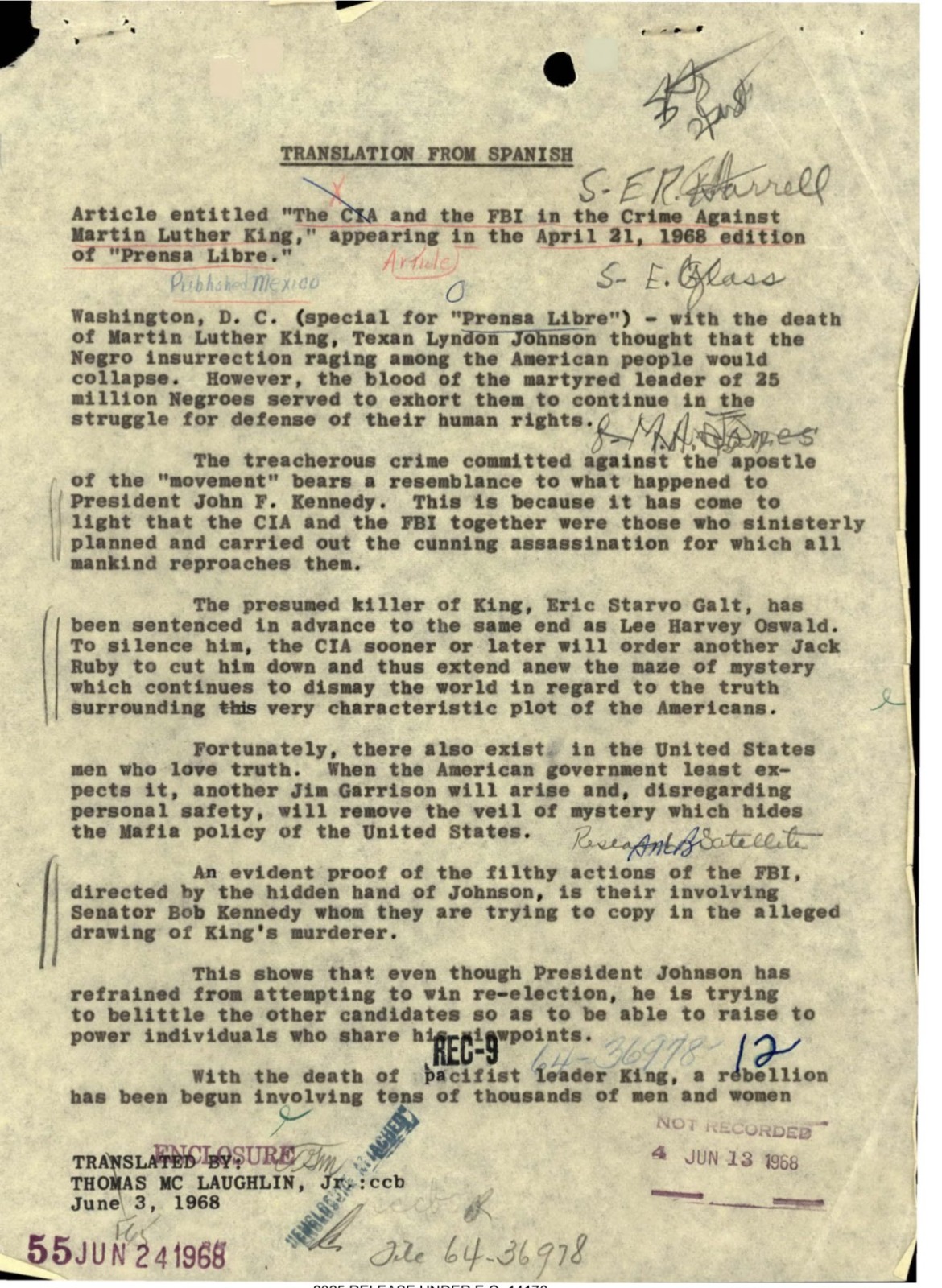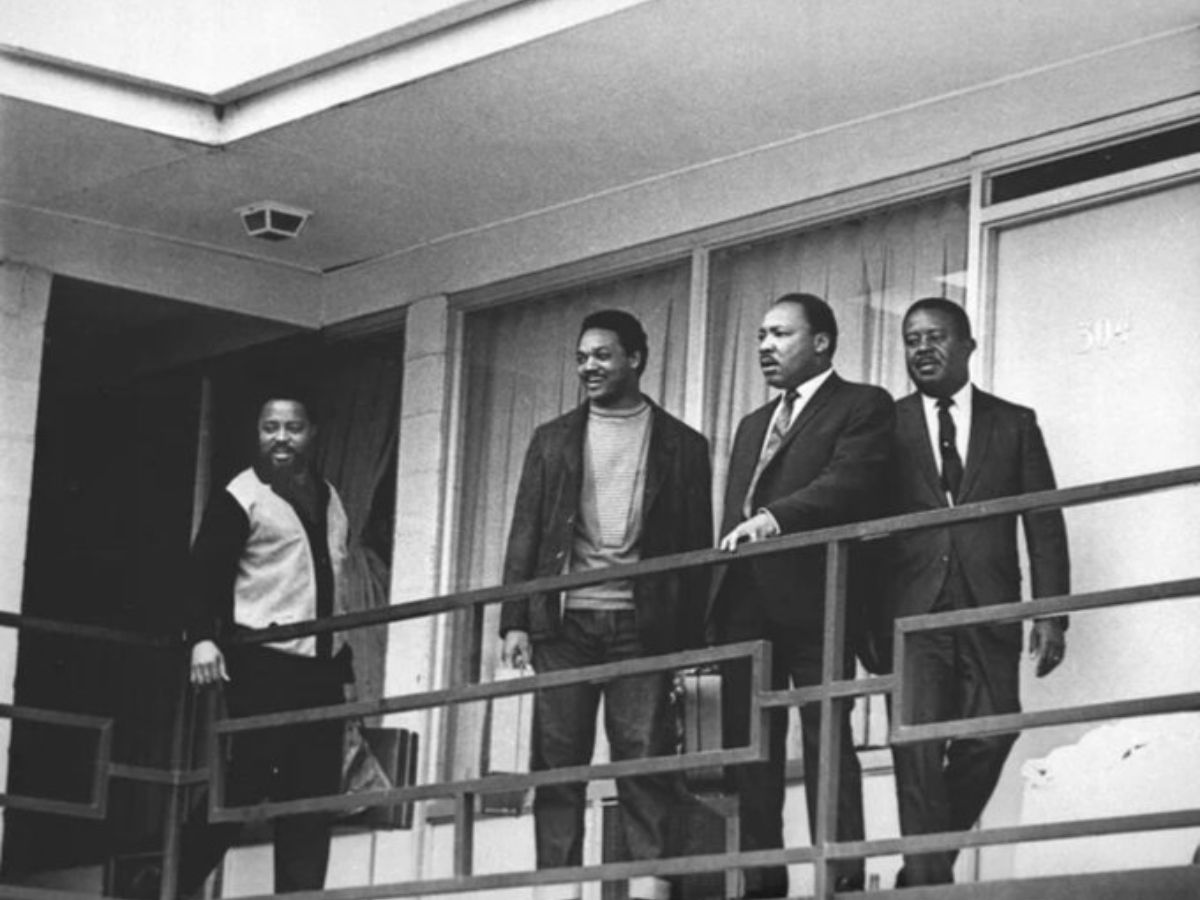The US National Archives has made public a vast collection of 230,000 documents related to the assassination of Dr. Martin Luther King Jr. The files were unveiled by DNI Tulsi Gabbard under President Donald trump’s executive order and include FBI memos, investigative leads, and statements from James Earl Ray’s former cellmate that hint at a possible conspiracy.
Trump’s Executive Order 1417 mandates full transparency concerning investigations into the assassinations of Dr. King, John F. Kennedy, and Robert F. Kennedy.
What MLK Files Reveal About FBI Activity Around the Dr. Martin Luther King Jr. Assassination
FBI memos from 1968 reveal the agency’s urgent efforts immediately following Dr. King’s assassination. One memo dated April 4, 1968, records agents urgently requesting the deletion of a wiretap transcript connected to “racial matters” shortly after King was shot.
Another document includes a statement from James Earl Ray’s former cellmate who claimed Ray spoke about killing King while they were imprisoned together. A separate memo requests expedited approval for wire surveillance, featuring crossed-out sections and handwritten edits, only days after the murder.
Today, after nearly 60 years of questions surrounding the assassination of Dr. Martin Luther King, Jr., we are releasing 230,000 MLK assassination files, available now at https://t.co/71P3p5jBgK. The documents include details about the FBI’s investigation into the assassination… pic.twitter.com/l96t9tgYmn
— DNI Tulsi Gabbard (@DNIGabbard) July 21, 2025
MLK Files on The Poor People’s Campaign and ‘Washington Spring Project’
The FBI chronology reveals Dr. King’s ambitious plan, known as the “Washington Spring Project,” aimed at shutting down Washington, D.C. with protests involving poor people, mule carts, and tent cities. King intended to bring thousands of supporters, including anti-war activists, to create a “City of Hope” shantytown near the Capitol, pressuring Congress to pass a $20 billion anti-poverty bill.
Government officials feared the protests might descend into chaos. FBI memos flagged National Guard constraints, while Speaker of the House Carl Albert (McCormack is likely an error) reportedly instructed police to block demonstrators “by any force necessary.”
The FBI closely monitored the Poor People’s Campaign ahead of its 1968 march, warning of a “massive campaign of disruption.” Agents flagged Coretta Scott King’s planned speech as a potential “call to arms” and kept tabs on mule caravans, foreign media coverage, and even rumored arson plots in Georgetown.
Allegations of Government Involvement in Dr. Martin Luther King Jr.’s Assassination
A translated 1968 article from the Guatemalan newspaper Prensa Libre accused the CIA and FBI of “sinisterly planning and carrying out” King’s assassination. The article alleged that James Earl Ray, referred to as Eric Galt, had been sentenced in advance and warned that the CIA might “order another Jack Ruby” to silence him.
It further accused federal authorities of using Robert F. Kennedy to divert attention from the alleged plot and drew parallels between King’s killing and the assassination of JFK.

Surveillance of Protest Movements
FBI reports from late 1968 outline a nationwide surveillance operation anticipating protests, uprisings, and what was described as a “major confrontation” in Washington, D.C., by the presidential inauguration in January 1969.
The Bureau tracked draft card returns, student activism through the Students for a Democratic Society (SDS), peace marches planned by military personnel, and conferences of Indigenous leaders, evangelicals, and police chiefs, all seen as potential flashpoints.
A 1968 memo highlighted fears of increasing militancy after King’s assassination, including coordinated Black student protests and unrest on military bases. The FBI linked these developments to a “nationwide resurgence of militant activity,” especially among young people, noting growing cooperation between Black Power groups and antiwar activists on campuses.

Concerns About Political Protests and Organizing
In November 1968, the FBI warned of a “new phase of political protest” gaining momentum, including student strikes, military resistance, and street actions aimed at disrupting the presidential inauguration.
The Bureau tracked draft resistance campaigns, Black student demands, and underground organizing by soldiers at bases such as Fort Lewis and Fort Jackson. It linked these efforts to broader dissent involving the Black Panthers and leftist groups, describing them under a unified “anti-U.S. government” movement
MlLK Files on Surveillance of Civil Rights Organizations
A 1968 FBI memo targeted the Southern Christian Leadership Conference (SCLC) and churches connected to the Poor People’s Campaign, labeling them as “organizational fronts” for “revolutionary” groups exploiting Dr. King’s legacy.
The FBI monitored clergy meetings, protest planning, and fundraising efforts, considering these activities national security threats. The memo expressed concern that Resurrection City, the shantytown protest site, could become a “permanent base of operation for Black extremist elements,” and warned of clergy “sympathetic to militants.”
CIA Files and Accusations
The CIA files reveal detailed surveillance on King, Coretta Scott King, and James Earl Ray. A 1976 memo showed the Agency had identified 82 documents related to them but acknowledged that 66 were destroyed in 1974 and two were lost. The remaining files include FBI reports on King’s speeches, fundraising, European travel, and rumors of assassination plots.
Despite the surveillance, the CIA claimed it did not assist the FBI in any operations aimed at discrediting King, though it tracked civil rights groups closely, citing fears of “communist infiltration.”
A 1966 surveillance operation monitored King and activist Bernard Lee from a hotel room in Miami, eavesdropping on private conversations and collecting personal information, including phone numbers and notes.

MLK Files on Bernard Fensterwald Jr.
The CIA opened a file on Bernard Fensterwald Jr. in 1969. Fensterwald, a Harvard Law graduate and former Senate counsel, founded the “Committee to Investigate Assassinations” and worked with Jim Garrison and Mark Lane. He challenged official reports on the JFK, RFK, and MLK assassinations and even represented James Earl Ray in 1971.
A 1975 memo revealed that the CIA had no file on James Earl Ray before the assassination, though Ray’s first lawyer, Arthur J. Hanes, was a former CIA correspondent.
In February 1969, theologian Dr. Nels F. S. Ferré publicly accused the CIA of orchestrating the assassinations of Dr. King and the Kennedy brothers during a Southern Baptist conference. The CIA memo notes Ferré’s claims were unchallenged by the audience and went unreported by the press.
A 1978 CIA memo to the House Select Committee on Assassinations confirmed no CIA information on Ray before 1966 but included files mentioning individuals linked to conspiracy theories. The same memo identified Soviet journalist and KGB officer Nikolay Leonov in photos connected to a CIA Mexico operation involving Lee Harvey Oswald.
Zubair Amin is a Senior Journalist at NewsX with over seven years of experience in reporting and editorial work. He has written for leading national and international publications, including Foreign Policy Magazine, Al Jazeera, The Economic Times, The Indian Express, The Wire, Article 14, Mongabay, News9, among others. His primary focus is on international affairs, with a strong interest in US politics and policy. He also writes on West Asia, Indian polity, and constitutional issues. Zubair tweets at zubaiyr.amin







